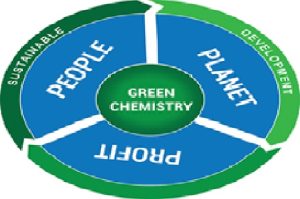Green Chemistry and Sustainability
By Dr. Hasan F. Alesary
Many chemicals are released into the environment either on purpose (like insecticides) while being used, unintentionally (like emissions during manufacturing), or through disposal. Green chemicals either break down into harmless compounds or are recycled for use later. The goal of such essay is to emphasize the importance of green chemistry and illustrate how such subject can be connected and be beneficial to the environment and this in turn can be of good results to sustainability.
The twelve green chemistry concepts can be loosely divided into two groups: those that focus on minimizing energy use and waste, and those that produce or use safer goods and procedures [1]. While putting these principles into practice will result in reduced energy consumption and less trash being dumped into the environment, these principles may also help to safeguard and enhance worker safety and health [2, 3]. Picture No. 1 demonstrate the relationship between the green chemistry and how it effects on the awareness of people, and this will lead to the development of the manners and methods that can help keep the planet on the safe side.

Moreover, health benefits, environmental advantages, and cost savings can all be maximized when worker dangers and risks are taken into account while designing or redesigning manufacturing processes in accordance with green principles. Similar to this, workplace safety and health requirements can improve worker health under public policies intended to support green chemistry technologies. Environmental sustainability and workplace safety and health have many things in common, which has been generally recognized. To achieve this more expansive definition of sustainability, some researchers “… recommend utilizing safety as an entry point for operationalizing sustainability for an organization, with a dual emphasis concentrating equally on human benefits and the commercial rationale” [4].
Additionally, by influencing molecular design, production methods, and product development in ways that preserve resources, use less energy, reduce pollution, and safeguard human health, green chemistry can enhance environmental sustainability. This strategy has been presented under “green” efforts. The workplace safety and health community has been very supportive of green chemistry-based projects [1–4]. There are numerous instances where people participating in “green” or renewable energy operations run a serious risk of being exposed to harmful substances. For instance, exposure to silane during the production of thin-film photovoltaic is extremely dangerous since it is pyrophoric and irritating to the skin and respiratory system [5]. Workers may be exposed to heavy metals like lead, mercury, and rare earth elements while recycling electronic debris [6, 7]. Workers are most frequently directly exposed to these risks when handling raw materials during product production, packaging, and transit, during product usage, or when items are eventually disposed of or recycled after their useful lives. When workplace safety and health are taken into account, however, the byproducts and outputs of processes that make use of green chemistry principles might be advantageous to workers. For instance, lowering the quantity of harmful intermediates used in chemical synthesis can reduce the danger of worker exposure.
On the other hand, people who utilize consumer goods at work may benefit from creating safer items for consumers. For instance, cleaners using less irritating cleaning supplies will probably have improved indoor air quality and lessen irritability among both workers and residents. Picture No. (2) displays the (12) principals of green chemistry

References
[1] Safer Jobs and a Sustainable Economy through Green Chemistry and Safer Alternatives in California: A Constituency Analysis.http://www.cleanwater.org/files/publications/ca/hellerreport.pdf,
[2] Hughes JC, LeGrande D, Zimmerman J, Wilson M, Beard S: Green chemistry and workers. New solutions: a journal of environmental and occupational health policy: NS. 2009, 19: 239-253. 10.2190/NS.19.2.dd.
[3] Ustailieva E, Starren A, Eeckelaert L, Nunes IL: Promoting occupational safety and health through the supply chain. 2012, Bilboa, Spain: European Agency for Safety and Health at Work.
[4] Cunningham TR, Galloway-Williams N, Geller ES: Protecting the planet and its people: how do interventions to promote environmental sustainability and occupational safety and health overlap?. J Safety Res. 2010, 41: 407-416. 10.1016/j.jsr.2010.08.002.
[5] Fthenakis VM: Chapter VII-2, Overview of Potential Hazards Practical in Handbook of Photovoltaics: Fundamentals and Applications. Handbook of Photovoltaics: Fundamentals and Applications. Edited by: Markvart T, Castaner L. 2003, Kidlington Oxford UK: Elsevier Publishing.
[6] Pinto VN: E-waste hazard: The impending challenge. Ind J Occup Environ Med. 2008, 12: 65-70. 10.4103/0019-5278.43263.
[7] Wath SB, Dutt PS, Chakrabarti T: E-waste scenario in India, its management and implications. Environ Monit Assess. 2011, 172: 249-262. 10.1007/s10661-010-1331-9


























































